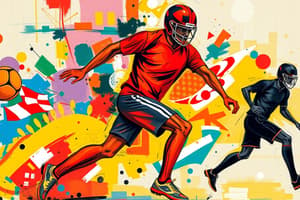Podcast
Questions and Answers
What does the principle of specificity in practice emphasize?
What does the principle of specificity in practice emphasize?
- Focusing solely on feedback after performance.
- Practicing in varied environments to foster adaptability.
- Practicing under conditions similar to the final desired skill. (correct)
- Increasing the frequency of practice sessions.
How does variability in practice contribute to motor learning?
How does variability in practice contribute to motor learning?
- It builds adaptability and stability through exposure to different situations. (correct)
- It focuses solely on repetitive drills for perfection.
- It discourages the use of feedback from previous performances.
- It allows learners to master a single movement without distractions.
Which assessment method evaluates the long-term retention of a learned skill?
Which assessment method evaluates the long-term retention of a learned skill?
- Performance measures that show immediate skill improvements.
- Intrinsic feedback gathered during practice.
- Retention testing that evaluates performance over time. (correct)
- Learning curves that visualize skill progression.
What role does intrinsic feedback play in skill learning?
What role does intrinsic feedback play in skill learning?
What is a motor programme in the context of skill acquisition?
What is a motor programme in the context of skill acquisition?
What characterizes the cognitive stage of motor learning?
What characterizes the cognitive stage of motor learning?
Which factor has the greatest impact on motor learning according to the content provided?
Which factor has the greatest impact on motor learning according to the content provided?
What is the primary focus during the associative stage of motor learning?
What is the primary focus during the associative stage of motor learning?
What type of feedback provides information on the outcome of the movement?
What type of feedback provides information on the outcome of the movement?
What best describes the autonomous stage of motor learning?
What best describes the autonomous stage of motor learning?
Which practice method is least effective for motor skill acquisition?
Which practice method is least effective for motor skill acquisition?
How does the environment influence motor learning?
How does the environment influence motor learning?
What is a typical outcome of effective feedback during motor learning?
What is a typical outcome of effective feedback during motor learning?
What is contractility in muscle cells?
What is contractility in muscle cells?
What does excitability in muscle cells refer to?
What does excitability in muscle cells refer to?
What is a limitation of the Motor Program Theory?
What is a limitation of the Motor Program Theory?
In the context of Generalized Motor Program Theory, what does GMP stand for?
In the context of Generalized Motor Program Theory, what does GMP stand for?
Which of these components must be specified within a motor program to generate skilled movements?
Which of these components must be specified within a motor program to generate skilled movements?
What does central fatigue refer to?
What does central fatigue refer to?
What challenge does the novelty problem present in Motor Program Theory?
What challenge does the novelty problem present in Motor Program Theory?
What role does MVIC (Maximal Voluntary Isometric Contraction) serve?
What role does MVIC (Maximal Voluntary Isometric Contraction) serve?
What distinguishes invariant features from parameters in the Generalized Motor Program Theory?
What distinguishes invariant features from parameters in the Generalized Motor Program Theory?
Which sequence correctly represents the process of performing an action according to the Generalized Motor Program Theory?
Which sequence correctly represents the process of performing an action according to the Generalized Motor Program Theory?
How does the execution of a forehand tennis stroke illustrate the Generalized Motor Program Theory?
How does the execution of a forehand tennis stroke illustrate the Generalized Motor Program Theory?
What role does relative timing play in the Generalized Motor Program Theory?
What role does relative timing play in the Generalized Motor Program Theory?
Which statement best describes the relationship between muscle activation and duration in a fast versus a slow stroke?
Which statement best describes the relationship between muscle activation and duration in a fast versus a slow stroke?
Match the following terms related to Generalized Motor Program Theory with their correct descriptions:
Match the following terms related to Generalized Motor Program Theory with their correct descriptions:
Match the following aspects of motor execution with their definitions in relation to movement:
Match the following aspects of motor execution with their definitions in relation to movement:
Match the following components of the forehand tennis stroke execution with their roles:
Match the following components of the forehand tennis stroke execution with their roles:
Match the following elements of motor programming process during an action with their correct order:
Match the following elements of motor programming process during an action with their correct order:
Match the following characteristics of a forehand stroke with their explanations:
Match the following characteristics of a forehand stroke with their explanations:
Match the terms related to muscle function with their descriptions:
Match the terms related to muscle function with their descriptions:
Match the components of a motor program with their functions:
Match the components of a motor program with their functions:
Match the problems associated with the Motor Program Theory:
Match the problems associated with the Motor Program Theory:
Match the features of a generalized motor program:
Match the features of a generalized motor program:
Match the functions of muscle characteristics with their definitions:
Match the functions of muscle characteristics with their definitions:
Match the types of fatigue with their descriptions:
Match the types of fatigue with their descriptions:
Match the aspects essential for skilled movements:
Match the aspects essential for skilled movements:
Match the concepts with their relevant descriptions:
Match the concepts with their relevant descriptions:
Flashcards
Motor Learning
Motor Learning
A long-term change in motor skill ability, improved through practice or experience.
Cognitive Stage
Cognitive Stage
Initial stage of motor learning, characterized by trial and error, focus on understanding the movement, and inconsistent performance.
Associative Stage
Associative Stage
Motor learning stage where movement patterns become more consistent, efficient, and refined.
Autonomous Stage
Autonomous Stage
Signup and view all the flashcards
Knowledge of Results (KR)
Knowledge of Results (KR)
Signup and view all the flashcards
Knowledge of Performance (KP)
Knowledge of Performance (KP)
Signup and view all the flashcards
Motor Control
Motor Control
Signup and view all the flashcards
Effective Feedback
Effective Feedback
Signup and view all the flashcards
Motor skill
Motor skill
Signup and view all the flashcards
Practice
Practice
Signup and view all the flashcards
Learning curve
Learning curve
Signup and view all the flashcards
Feedback
Feedback
Signup and view all the flashcards
Specificity
Specificity
Signup and view all the flashcards
GMP
GMP
Signup and view all the flashcards
Invariant Features
Invariant Features
Signup and view all the flashcards
Parameters
Parameters
Signup and view all the flashcards
Response Selection
Response Selection
Signup and view all the flashcards
Movement Programming
Movement Programming
Signup and view all the flashcards
Contractility
Contractility
Signup and view all the flashcards
Excitability
Excitability
Signup and view all the flashcards
Central Fatigue
Central Fatigue
Signup and view all the flashcards
Maximal Voluntary Isometric Contraction (MVIC)
Maximal Voluntary Isometric Contraction (MVIC)
Signup and view all the flashcards
Motor Program
Motor Program
Signup and view all the flashcards
Generalized Motor Program (GMP)
Generalized Motor Program (GMP)
Signup and view all the flashcards
Relative Timing
Relative Timing
Signup and view all the flashcards
Study Notes
Introduction to Motor Learning
- Motor learning is a relatively permanent change in the capability to perform a motor skill as a result of practice or experience.
- It's distinct from motor control, which refers to the mechanisms for producing movement. Motor learning is the process, motor control is the execution.
- Key characteristics include: improvement, consistency, stability, and adaptability.
- Motor learning is a complex process involving multiple interacting components: cognitive, associative, and autonomous stages.
Stages of Motor Learning
- Cognitive Stage:
- Characterized by trial-and-error attempts.
- Learner focuses on understanding the task and figuring out the general movement pattern.
- Performance is variable and inconsistent, prone to errors.
- Feedback is crucial.
- Associative Stage:
- Learner refines the movement pattern and begins to develop more consistent performance.
- Focus shifts to improving efficiency and accuracy during movement execution.
- Learning becomes more specific, refining task-specific adjustments.
- The learner develops more effective strategies for error correction.
- Autonomous Stage:
- Motor skill becomes automatic and requires minimal attention and conscious effort.
- Performance is highly consistent and efficient.
- Learners can adjust the skill effortlessly to changing environments.
- The brain frees up cognitive resources for higher-order activities.
Factors Affecting Motor Learning
- Motivation and Attention:
- Intrinsic motivation and a focused attention on the task are crucial.
- External rewards and incentives are not as effective as self-motivation.
- Practice:
- Guided practice, variable practice and active practice are helpful.
- Deliberate practice focusing on specific aspects of the skill is beneficial.
- Feedback:
- Effective feedback is crucial for motor skill acquisition.
- Knowledge of results (KR) provides the outcome, while knowledge of performance (KP) provides information on the movement.
- Timing, frequency, and clarity of feedback are important influencers.
- Individual Differences:
- Learning is influenced by factors like age, physical condition, gender, and personality.
- Different learners may require varying levels of instruction, feedback, or practice.
- Environment:
- Physical environment and presence of distractions can impact learning.
- A supportive and encouraging environment promotes motor skill acquisition.
Principles of Effective Practice
- Specificity: Practice should mirror the conditions of the final, targeted skill.
- Variability: Exposure to different movement and situational variations builds adaptability and stability.
- Massed vs Distributed Practice: The frequency and timing of practice sessions influence learning.
- Intrinsic Feedback: Learners should develop a feel for the task, using sensations in the body and environment.
- Transfer of Training: Training on related skills can help improve specific movements or skills.
Assessment of Motor Learning
- Performance Measures: Track improvements in accuracy, speed, and consistency of skill.
- Retention Testing: Evaluate the continued performance of the learned skill over time.
- Learning Curves: Visualize and quantify the improvement during the learning process
Key Concepts and Terms
- Motor skill: Specific action requiring a body movement
- Practice: Repetition of a motor skill
- Feedback: Information provided to a learner following a movement
- Motor programme: Internal representation of the motor action and movement sequence
- Learning curve: Graphic depiction of skill acquisition progress
Studying That Suits You
Use AI to generate personalized quizzes and flashcards to suit your learning preferences.




